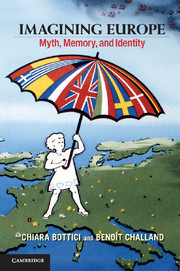43 results
Penny A. Weiss (editor), Feminist Manifestos: A Global Documentary Reader. New York: New York University Press, 2018 (ISBN: 978-4798-3730-4)
-
- Journal:
- Hypatia Reviews Online / Volume 2019 / 2019
- Published online by Cambridge University Press:
- 01 October 2021, E1
- Print publication:
- 2019
-
- Article
-
- You have access
- Export citation
Conclusion
-
- Book:
- Imagining Europe
- Published online:
- 05 July 2013
- Print publication:
- 29 July 2013, pp 167-178
-
- Chapter
- Export citation
5 - Europe's Significant Others
-
- Book:
- Imagining Europe
- Published online:
- 05 July 2013
- Print publication:
- 29 July 2013, pp 113-144
-
- Chapter
- Export citation
Introduction
-
- Book:
- Imagining Europe
- Published online:
- 05 July 2013
- Print publication:
- 29 July 2013, pp 1-12
-
- Chapter
- Export citation
4 - Myths of Europe
-
- Book:
- Imagining Europe
- Published online:
- 05 July 2013
- Print publication:
- 29 July 2013, pp 87-112
-
- Chapter
- Export citation
Part II - Myth and Identity
-
- Book:
- Imagining Europe
- Published online:
- 05 July 2013
- Print publication:
- 29 July 2013, pp 85-86
-
- Chapter
- Export citation
Bibliography
-
- Book:
- Imagining Europe
- Published online:
- 05 July 2013
- Print publication:
- 29 July 2013, pp 179-200
-
- Chapter
- Export citation
Index
-
- Book:
- Imagining Europe
- Published online:
- 05 July 2013
- Print publication:
- 29 July 2013, pp 201-205
-
- Chapter
- Export citation
Acknowledgments
-
- Book:
- Imagining Europe
- Published online:
- 05 July 2013
- Print publication:
- 29 July 2013, pp xi-xiv
-
- Chapter
- Export citation
Frontmatter
-
- Book:
- Imagining Europe
- Published online:
- 05 July 2013
- Print publication:
- 29 July 2013, pp i-iv
-
- Chapter
- Export citation
3 - East and West
-
- Book:
- Imagining Europe
- Published online:
- 05 July 2013
- Print publication:
- 29 July 2013, pp 65-84
-
- Chapter
- Export citation
2 - European Identity and the Politics of Remembrance
-
- Book:
- Imagining Europe
- Published online:
- 05 July 2013
- Print publication:
- 29 July 2013, pp 41-64
-
- Chapter
- Export citation
Abbreviations
-
- Book:
- Imagining Europe
- Published online:
- 05 July 2013
- Print publication:
- 29 July 2013, pp ix-x
-
- Chapter
- Export citation
6 - From Hammer and Sickle to Crescent
-
- Book:
- Imagining Europe
- Published online:
- 05 July 2013
- Print publication:
- 29 July 2013, pp 145-166
-
- Chapter
- Export citation
Contents
-
- Book:
- Imagining Europe
- Published online:
- 05 July 2013
- Print publication:
- 29 July 2013, pp v-vi
-
- Chapter
- Export citation
Part I - Memory and Identity
-
- Book:
- Imagining Europe
- Published online:
- 05 July 2013
- Print publication:
- 29 July 2013, pp 13-14
-
- Chapter
- Export citation
List of Figures, Tables, and Graphs
-
- Book:
- Imagining Europe
- Published online:
- 05 July 2013
- Print publication:
- 29 July 2013, pp vii-viii
-
- Chapter
- Export citation
1 - Europe, Identity, and Legitimacy
-
- Book:
- Imagining Europe
- Published online:
- 05 July 2013
- Print publication:
- 29 July 2013, pp 15-40
-
- Chapter
- Export citation

Imagining Europe
- Myth, Memory, and Identity
-
- Published online:
- 05 July 2013
- Print publication:
- 29 July 2013
Chapter 15 - European Identity and the Politics of Remembrance
-
-
- Book:
- Performing the Past
- Published by:
- Amsterdam University Press
- Published online:
- 15 January 2021
- Print publication:
- 15 July 2012, pp 335-360
-
- Chapter
- Export citation

